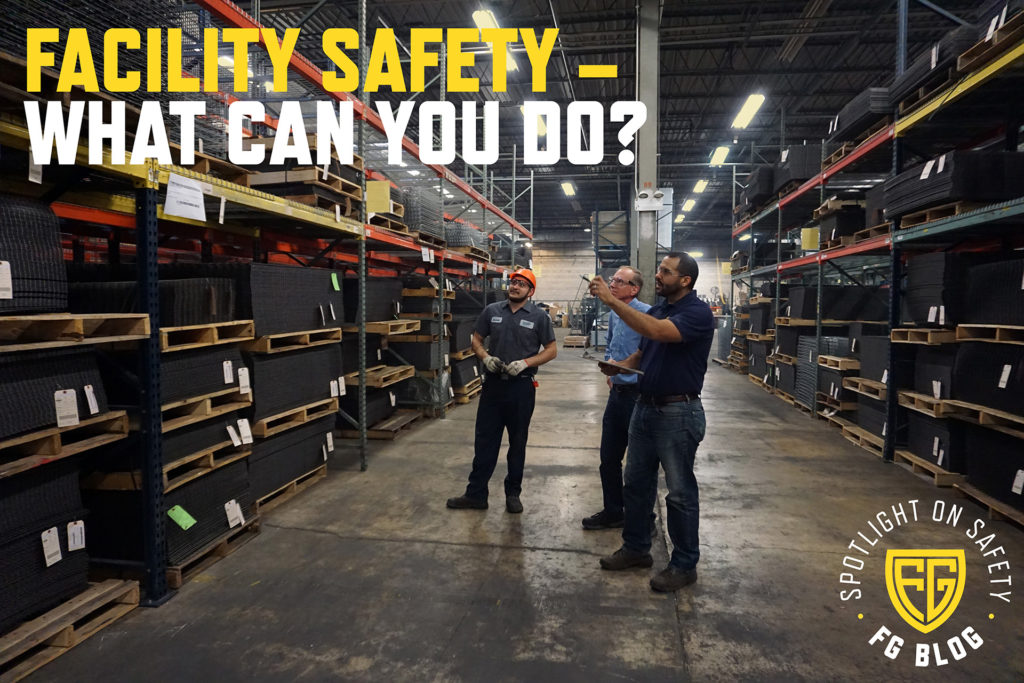Facility Safety – What can you do?

Welcome to Folding Guard’s Monthly Spotlight on Safety!
We’re kicking off this series with an all-important question:
HOW CAN I KEEP MY FACILITY SAFE?
This is the most important question any supervisor or facility employee can ask themselves. Just by asking it, you’ve already shown initiative and taken a great step toward accomplishing your goal.
Broadly speaking, safety can be accomplished by remembering these three key words: awareness, communication, and action.
AWARENESS
In any situation, but especially in a factory or facility setting where hazardous situations can occur at any moment, everyone should be aware of their surroundings at all times. This is a policy that should start from the top down. Supervisors can and should do walk-throughs of their facilities on a weekly basis, if not more frequently, to be aware of any changes or problems throughout the facility. Equipment could be faulty, structures could become rusty or worn, even signage around dangerous chemicals could be outdated or hard to read. Simply by doing regular walk-throughs and being aware of the state of your facility, you will be able to spot any potential hazards and stop them before they become a problem.
On the floor, employees need to be constantly aware of their surroundings. They are working around moving vehicles, robotics, power tools, and other hazardous materials all day, and safety needs to be everyone’s number one priority. PPE, or Personal Protective Equipment, such as helmets, protective eyewear, gloves, and steel-toed boots are of course the first physical line of defense against workplace hazards, but awareness needs to be the first mental line of defense. Awareness can prevent immediate danger, but it can also prevent small irritations from becoming longer term problems, which leads us to our next step toward safety:
COMMUNICATION
Communication is catalyst that turns awareness into action. When an employee becomes aware of a problem, they need to feel comfortable communicating it to a supervisor. This can be achieved in a number of ways. First of all, make sure you are catering to all languages spoken in your facility. Even if everyone knows enough English to get by, safety concerns should be communicated in the language that an employee feels the most comfortable speaking, so that nothing gets mistranslated or miscommunicated. Make sure there are multilingual supervisors in all chains of command, or at least someone who feels comfortable translating in those situations. Next, make sure that there are multiple channels of communication for non-emergency concerns. Some people might not feel comfortable expressing concerns or offering suggestions for fear of calling out negligence or speaking up if they’re normally soft-spoken. In these cases, we recommend having a Safety Suggestion Box. This box is a great way to encourage employees of all levels to offer suggestions and express (non-urgent) concerns in any language, knowing that they will be read and addressed in a timely manner. Which leads us to our next key word:
ACTION
Action is the most decisive step you can take to ensure the safety of your facility. Whether it’s immediately addressing the urgent concern of a floor worker or following up on a problem you found during a weekly safety audit, action must be taken to keep your employees and your facility safe at all times. Safety is a daily, ongoing project that is everyone’s responsibility. Watch this blog for a monthly Spotlight on Safety, where we’ll take a more detailed dive into things like Gemba Walks, Safety Audits, PPE, and more! But for now, remember to be AWARE, to COMMUNICATE, and to take ACTION to maintain a safe workplace at all times!
